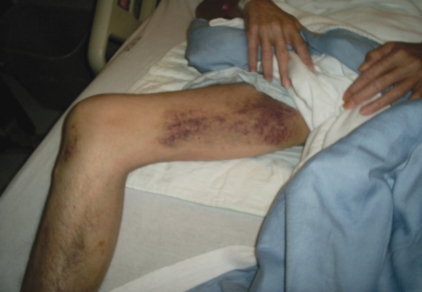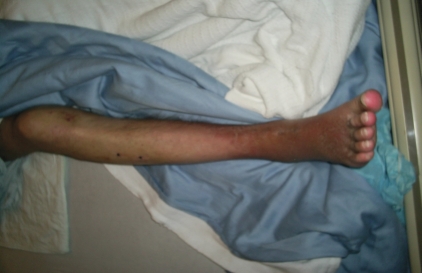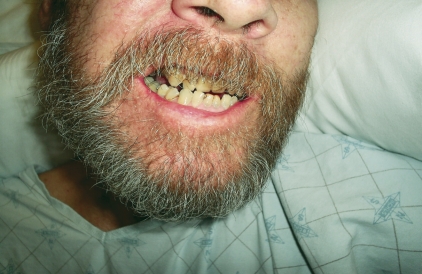Case description
A 47-year-old male presented to the emergency department with a progressive onset of confusion, lethargy, anorexia, fatigue, weakness, and a diffuse nonpruritic perifollicular rash. Over the previous 6 months, the patient had lost 5 to 6 kg. He had multiple spontaneous hematomas on his lower extremities (Figure 1).
Figure 1.
Large hematoma on the inner right thigh
After initial supportive treatment, results of primary investigations revealed a normocytic normochromic anemia with a hemoglobin level of 64 g/L. Two units of packed red blood cells were transfused. Electrolytes, platelets, kidney function, liver enzymes, liver function, calcium, magnesium, ammonia levels, and blood glucose were all within normal limits. Results of a fecal occult blood test were negative. Ferritin, folate, and vitamin B12 levels were normal. Results of the toxicology screen were negative.
After the patient was admitted, urine cultures and blood cultures were found to be negative for bacteria. An abdominal ultrasound scan revealed a mild fatty liver with fibrotic changes; however, there was no evidence of cirrhosis or portal hypertension. Bilateral Doppler ultrasound scans of the legs were negative. A computed tomography head scan revealed moderate cerebral and cerebellar atrophy but no evidence of any acute events or intracranial masses. A skin punch biopsy of the perifollicular rash was sent for assessment.
During the patient’s admission, a nutritionist was consulted in order to evaluate his anorexia and weight loss. The report revealed a fairly consistent, regular, and habitual diet of coffee for breakfast, a sandwich for lunch (egg salad, ham and cheese, or peanut butter and banana) along with 2% milk. For dinner, the patient would normally eat either frozen dinners (mostly lasagna) or, on occasion, a small portion of steak, which he would cook himself. Snacks consisted mostly of crackers. He acknowledged drinking 8 to 10 beers per day. The patient was not taking any supplements or vitamins. His diet was very limited in fresh fruits and vegetables. He did not like eating seafood or fish. Consequently, he was started on a daily multivitamin as well as 100 mg of thiamine daily.
Results of the skin biopsy demonstrated evidence of follicular hyperkeratosis, focal perifollicular hemorrhages (Figure 2), and mild chronic inflammation. Corkscrew hairs were also noted. Pathologic features were consistent with vitamin C deficiency. Consequently, a vitamin C serum assay was performed, which showed levels of < 10 μmol/L (normal being 45 to 90 μmol/L). The diagnosis of scurvy was made.
Figure 2.
Perifollicular hemorrhages
History
A literature search using MEDLINE and key words such as scurvy, ascorbic acid, vitamin C deficiency, and alcohol was used to prepare this article.
Ascorbic acid, or vitamin C, was first isolated in 1928 by Albert Szent-Gyorgyi of Hungary, an achievement for which he was awarded the Nobel Prize in medicine in 1937.
However, vitamin C—or at least the effects of its deficiency—had long been well known and became a serious issue among mariners in the 15th and 16th centuries when the devastating health effects became evident on long voyages.
In 1747, James Lind, a British Royal Navy surgeon, conducted what was to be considered the first example of a controlled experiment aboard his ship.1,2 Aware of the lethal effects of scurvy, Lind selected 12 men suffering from the condition aboard the HMS Salisbury and divided them into 6 groups of 2. In addition to the daily rations they received, Lind provided oranges and lemons to one group, while the other groups received cider, vinegar, seawater, or a mixture of garlic, mustard, and horseradish. Those given the citrus fruits quickly and fully recovered, leading Lind to conclude that oranges and lemons prevented scurvy. From that day forward, citrus juices from oranges, lemon, and especially limes were used by the “limeys” of the Royal Navy to prevent and cure scurvy. James Lind published his findings in the “Treatise on the Scurvy” in 1753.
Twentieth-century research3–7 has demonstrated that most animals and plants are able to synthesize their own vitamin C. In fact, goats are known to manufacture approximately 13 000 mg of vitamin C per day when healthy, and can increase their production to 100 000 mg daily when faced with illness, trauma, or stress.4 However, scientists were able to determine that humans possess only 3 of the 4 enzymes needed to synthesize ascorbic acid. According to researchers, the fourth enzyme seems to be defective. Theories of mutation, evolution, or inborn errors have been postulated, but no one completely understands the nature of this situation.4
Function
Ascorbic acid plays an essential role in the hydroxylation of collagen. This crucial biochemical pathway enables each collagen fibril to form a uniform and flexible triple helix configuration in the body’s connective tissues. Some tissues such as skin, gums, mucus membranes, and bones contain a greater concentration of collagen and thus are more susceptible to deficiencies. Ascorbic acid is also needed in the synthesis of dopamine, norepinephrine, epinephrine, and carnitine. The latter acts as an important energy transfer tool by taking fatty acid chains from the cell cytosol and transferring them to the mitochondria for energy production. Despite all these specific and unique functions, most people recognize vitamin C for its antioxidant properties and its ability to enhance iron absorption from the intestinal tract.8
Sources
Because humans are unable to synthesize ascorbic acid, we obtain our daily requirements from natural sources, such as citrus fruits (oranges, lemons, limes, grapefruits) and vegetables (potatoes, broccoli, spinach, Brussels sprouts, red peppers). Ascorbic acid can be easily destroyed by heat; therefore, many foods can lose their ascorbic acid content because of cooking, storage, or oxidation. Ascorbic acid is absorbed from the intestinal tract and has a biological half-life of approximately 30 minutes. There is no storage site in the body; however, some tissues carry higher concentrations (white blood cells, adrenal glands, pituitary gland).8
Deficiency
According to Health Canada’s food and nutrition guidelines, the recommended requirement of vitamin C is between 75 and 90 mg per day. Clinical manifestations of scurvy can be seen within 8 to 12 weeks of irregular or inadequate intake. Presentation can vary by individual. Early stages are often characterized by malaise, fatigue, and lethargy. One to 3 months of inadequate intake can lead to anemia, myalgia, bone pain, easy bruising (Figure 3), swelling, petechiae, perifollicular hemorrhages, corkscrew hairs, gum disease (Figure 4), poor wound healing, mood changes, and depression. Perifollicular hemorrhages and easy bruising are often first seen in the lower extremities, as capillary fragility leads to an inability to withstand hydrostatic pressure. Late stages of scurvy are more severe and life threatening; common manifestations include generalized edema, severe jaundice, hemolysis, acute spontaneous bleeding, neuropathy, fever, convulsions, and death.6
Figure 3.
Multiple bruises on the left arm
Figure 4.
Gum line hypertrophy and gingival bleeding
Risk factors
The most common risk factors stated in the literature are alcoholism, low socioeconomic status, and severe psychiatric illness leading to poor nutrition.7 In a retrospective chart review conducted at the Mayo Clinic in Rochester, NY, and Scottsdale, AZ, from 1976 to 2002, 10 of 12 scurvy cases were related to alcohol abuse, illicit drug use, and psychiatric disorders.8 Other risk factors include fad diets, routine diets, and severe allergies to food products.9 Anorexia nervosa, Crohn disease, celiac disease, and hemodialysis patients have also been documented as having increased susceptibility to ascorbic acid deficiency (as well as other common nutritional deficiencies).
Alcohol and ascorbic acid
The effects of alcohol on ascorbic acid metabolism are poorly understood. In a small study of 9 healthy middle-aged men, alcohol consumption (0.58 g/kg) produced a 47% increase in urinary ascorbic acid excretion 4 hours after ingestion.10 A small comparative study of 13 healthy men pretreated with high doses of vitamin C (2 g/d for 2 weeks) before alcohol consumption (0.8 g/kg) demonstrated a significant increase in plasma alcohol clearance when compared with a non-pretreated group.11 The literature suggests a correlation between alcohol metabolism and ascorbic acid excretion; however, the mechanism remains unknown. These poorly understood interactions might leave individuals who abuse alcohol at higher risk of developing scurvy. Therefore, clinicians should have a higher index of suspicion for scurvy in the clinical presence of long-term alcohol abuse or dependence.
Treatment and prognosis
The treatment for scurvy is vitamin C supplementation. Recommendations are that 1 to 2 grams of vitamin C be administered daily for the first 2 to 3 days followed by 500 mg per day for the next week. Afterward, a daily intake of 100 mg of vitamin C should be given for 1 to 3 months. Symptoms of fatigue, lethargy, pain, anorexia, and confusion improve within 24 hours of supplementation. Bruising, perifollicular hemorrhages, gingival bleeding, and weakness usually improve within 1 to 2 weeks. Corkscrew hairs regain normal appearance by 4 weeks. Complete recovery should be anticipated after approximately 3 months of regular vitamin C supplementation.7
Conclusion
Early recognition of nutritional deficiencies, such as scurvy, can be difficult because symptoms are often vague and nonspecific and can mimic a variety of more common conditions. It is important to continue acknowledging the role of nutrition in health in order to promote healthy lifestyles and help prevent serious life-threatening illnesses.
Acknowledgment
I thank Dr Raymond Kao, Dr Anna Pawelec-Brzychczy, Dr Stacey Valiquet, Dr Daniel Ovakim, and Dr Gnanakumar for their assistance with this article.
EDITOR’S KEY POINTS
Cases of scurvy, or ascorbic acid deficiency, can be difficult to diagnose because cases are relatively rare and early symptoms tend to be vague and nonspecific.
In the early stages, patients can present with fatigue, lethargy, and malaise. After several months of vitamin C deficiency, a range of symptoms and signs can occur, including anemia, myalgia, bone pain, easy bruising, swelling, petechiae, gum disease, poor wound healing, and depression. Late stages of scurvy are life threatening.
If scurvy is suspected, clinicians should be on the lookout for alcohol or drug abuse, psychiatric disorders, severe food allergies, Crohn disease, celiac disease, hemodialysis, and fad or other diets, all of which can be contributing factors.
Treatment consists of a regimen of vitamin C supplementation. Complete recovery usually occurs after 3 months of regular supplementation.
POINTS DE REPÈRE DU RÉDACTEUR
Il peut être difficile de diagnostiquer le scorbut, ou carence en acide ascorbique, parce que les cas sont relativement rares et les premiers symptômes sont habituellement vagues et non spécifiques.
Au début, les patients ressentent de la fatigue, une certaine léthargie et un malaise. Après plusieurs mois de carence en vitamine C, différents symptômes et signes peuvent se produire, comme l’anémie, la myalgie, une douleur dans les os, une propension aux ecchymoses, l’enflure, des pétéchies, des maladies des gencives, la guérison difficile des plaies et la dépression. Les derniers stades du scorbut peuvent causer la mort.
Si les cliniciens soupçonnent le scorbut, ils devraient être à l’affût de l’alcoolisme ou de la toxicomanie, des troubles psychiatriques, des allergies alimentaires graves, de la maladie de Crohn, de la maladie cœliaque, de l’hémodialyse, des régimes alimentaires à la mode ou autres, qui peuvent tous être des facteurs en cause.
Le traitement consiste en un régime de suppléments de vitamine C. Le rétablissement complet se produit habituellement après 3 mois de traitement régulier.
Footnotes
Competing interests
None declared
Cet article a fait l’objet d’une révision par des pairs.
This article has been peer reviewed.
References
- 1.Carpenter KJ. A short history of nutritional sciences: part 1 (1785–1885). The American Society of Nutritional Sciences. J Nutr. 2003;133(3):638–45. doi: 10.1093/jn/133.3.638. [DOI] [PubMed] [Google Scholar]
- 2.Carpenter KJ. A short history of nutritional sciences: part 2 (1885–1912). The American Society of Nutritional Sciences. J Nutr. 2003;133(4):975–84. doi: 10.1093/jn/133.4.975. [DOI] [PubMed] [Google Scholar]
- 3.Chaudhry SI, Newell EL, Lewis RR, Black MM. Scurvy: a forgotten disease. Clin Exp Dermatol. 2005;30(6):735–6. doi: 10.1111/j.1365-2230.2005.01901.x. [DOI] [PubMed] [Google Scholar]
- 4.Stone I. Eight decades of scurvy. The case history of a misleading dietary hypothesis. Orthomolecular Psychiatry. 1979;8:58–62. [Google Scholar]
- 5.Stone I. Eight decades of scurvy. Australas Nurses J. 1979;8(11):28–30. [PubMed] [Google Scholar]
- 6.Wang AH, Still C. Old world meets modern: a case report of scurvy. Nutr Clin Pract. 2007;22(4):445–8. doi: 10.1177/0115426507022004445. [DOI] [PubMed] [Google Scholar]
- 7.De Luna RH, Colley BJ, 3rd, Smith K, Divers SG, Rinehart J, Marques MB. Scurvy: an often forgotten cause of bleeding. Am J Hematol. 2003;73(1):85–7. doi: 10.1002/ajh.10354. [DOI] [PubMed] [Google Scholar]
- 8.Olmedo JM, Yiannias JA, Windgassen EB, Gornet MK. Scurvy: a disease almost forgotten. Int J Dermatol. 2006;45(8):909–13. doi: 10.1111/j.1365-4632.2006.02844.x. [DOI] [PubMed] [Google Scholar]
- 9.Des Roches A, Paradis L, Paradis S, Singer S. Food allergy as a new risk factor for scurvy. Allergy. 2006;61(12):1487–8. doi: 10.1111/j.1398-9995.2006.01200.x. [DOI] [PubMed] [Google Scholar]
- 10.Faizallah R, Morris AI, Krasner N, Walker RJ. Alcohol enhances vitamin C excretion in the urine. Alcohol. 1986;21(1):81–4. [PubMed] [Google Scholar]
- 11.Chen MF, Boyce HW, Jr, Hsu HM. Effect of ascorbic acid on plasma alcohol clearance. J Am Col Nutr. 1990;9(3):185–9. doi: 10.1080/07315724.1990.10720368. [DOI] [PubMed] [Google Scholar]






